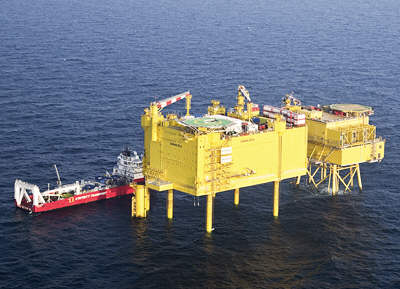|
Siemens hands over first North Sea grid
connection to TenneT
A significant step for the
German energy transition
»
The world's largest direct-current grid connection at 800 megawatts
(MW) has now taken up commercial operation
»
The grid connection's transmission capacity is enough to supply
around one million German households with power
2015-Jan-30
+ + + Siemens has handed over the first North Sea grid connection,
BorWin2, to its customer TenneT. The German-Dutch transmission grid
operator has accepted the project following successful completion of test
runs by Siemens. The grid connection is therefore now in commercial
operation. The offshore platform of the BorWin2 grid connection is located
around 100 kilometers off the German coast – northwest of the island of
Borkum, after which the project was named. With this grid connection it is
now possible to transmit 800 MW of clean electricity from wind power,
enough to supply around one million German households.
"This is the first offshore grid connection worldwide to take up
commercial operation with efficient direct-current technology. We are
proud that Siemens mastered and completed this demanding and challenging
project, despite the many difficulties that working far out at sea
presented", stated Jan Mrosik, CEO of the Siemens Energy Management
Division. "The BorWin2 link is a major contribution to the energy
transition", stressed Lex Hartman, member of the managing board of TenneT
TSO GmbH. "The connection's capacity of 800 megawatts is equivalent to the
capacity required for supplying one million private households."
The BorWin2 offshore platform is 51 meters
wide, 72 meters long, 25 meters high and, with its baseframe, weighs
around 16,000 metric tons. Siemens installed the platform at this
39-meter-deep North Sea location back in April 2014. The Global Tech 1
wind farm, with its 80 wind turbines, is linked to BorWin2. Fifty percent
of the grid connection capacity of BorWin2 is available for connection of
a second wind farm.
The network operator TenneT contracted the
consortium consisting of Siemens and the Italian cable specialist Prysmian
for the BorWin2 offshore grid connection in summer 2010. Siemens is now
implementing five North Sea grid connection projects for TenneT: HelWin1
(576 MW) and HelWin2 (690 MW) off of Helgoland, BorWin2 (800 MW) and
BorWin3 (900 MW) off of Borkum and SylWin1 (864 MW) off of Sylt.
The next three grid connections, Sylwin1, HelWin1 and HelWin2, are nearly
completed and are scheduled to take up commercial operation in the first
half of 2015. Siemens received its latest order for a grid connection in
the North Sea, BorWin3, in a consortium with Petrofac in the spring of
2014. Commissioning of this fifth grid connection from Siemens is
scheduled for 2019. The grid connections implemented by Siemens for TenneT
will have a total transmission capacity of more than 3.8 gigawatts (GW),
providing electricity from offshore wind power to supply around five
million households.
Thanks to the Siemens high-voltage direct-current (HVDC) technology,
transmission losses for each grid connection, including cable losses, are
less than four percent. This Siemens HVDC technology is installed on the
offshore platforms and in the land-based converter stations. The
wind-based electricity is transmitted as alternating current to the
converter platform, transformed into direct current and fed to the
mainland via a subsea cable. The land-based station converts the direct
current back into alternating current and feeds the electricity into the
extra-high voltage grid. HVDC is the only efficient transmission solution
for cable lengths of more than 80 kilometers.
The HVDC Plus technology used by Siemens is
less complex and extremely compact, making it predestined for use in
sea-based applications. In contrast to classic HVDC technology used in a
vast majority of land links, systems equipped with HVDC Plus feature
self-stabilization. As fluctuations in the grid must always be reckoned
with for wind-based power generation, grid stability and reliability is
enhanced considerably through the use of the Siemens HVDC Plus technology.
More information about
the Energy Management Division is available at
www.siemens.com/energy-management
Source: Stefan Wagner,
Siemens Munich,
Sabrina Martin, Siemens Erlangen
www.siemens.com
|

Worldwide more than
90,000 paid subscriptions

Worldwide
more than 48,000 subscriptions -
100% one-year direct request
qualification

'What's New' in Upstream, Midstream and
Downstream Products & Services. Circulation 37,000
PennWell
Petroleum Group:
Oil & Gas Journal
Oil & Gas Journal Russia
OGJ_eNewsletter
OGJ-Website-Statistics
Oil, Gas & Petrochem Equipment
Offshore Magazine
Offshore
Russia
Offshore eNewsletter
Offshore
Website Statistics
Oil & Gas Financial Journal
+ + +
For more information, media
kits or
sample copies please contact
Andreas
Sicking
+49 (0)2903-338570
wilhelms@pennwell.com
www.sicking.de
|


